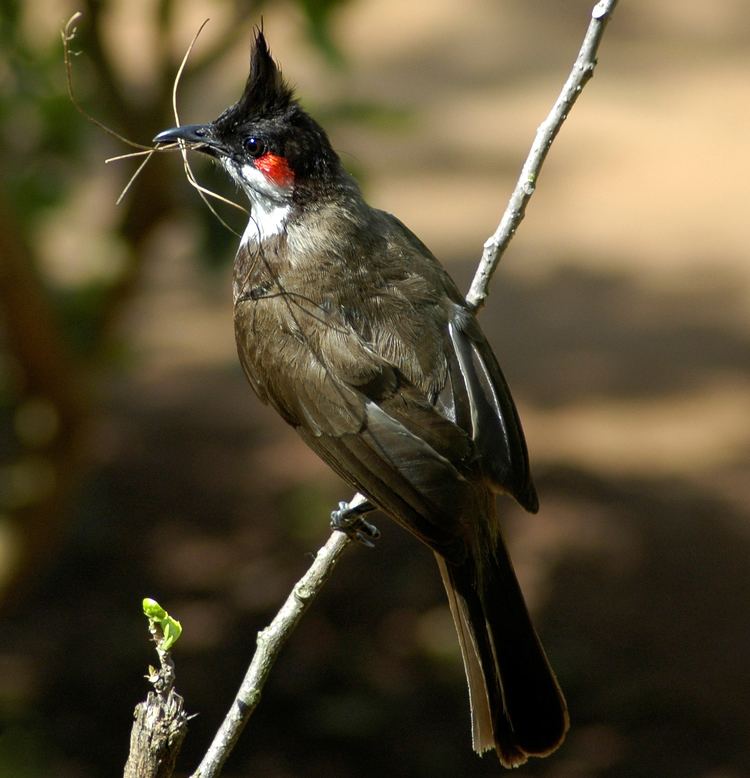Suborder Passeri Higher classification Passerine Rank Family | Order Passeriformes Scientific name Pycnonotidae Phylum Chordata | |
 | ||
Lower classifications Red‑whiskered bulbul, Pycnonotus, Black bulbul, Hypsipetes, Brown‑eared bulbul | ||
Red whiskered bulbul bird singing
The bulbuls are a family, Pycnonotidae, of medium-sized passerine songbirds. Many forest species are known as greenbuls, brownbuls, leafloves, or bristlebills. The family is distributed across most of Africa and into the Middle East, tropical Asia to Indonesia, and north as far as Japan. A few insular species occur on the tropical islands of the Indian Ocean There are about 130 species in around 24 genera. While some species are found in most habitats, overall African species are predominantly found in rainforest whilst rainforest species are rare in Asia, instead preferring more open areas.
Contents
- Red whiskered bulbul bird singing
- Description
- Systematics
- Systematic list
- Relationship to humans
- References
The word bulbul derives from Arabic: بلبل, meaning nightingale, but in English, bulbul refers to passerine birds of a different family.
Description
Bulbuls are short-necked slender passerines. The tails are long and the wings short and rounded. In almost all species the bill is slightly elongated and slightly hooked at the end. They vary in length from 13 cm for the tiny greenbul to 29 cm in the straw-headed bulbul. Overall the sexes are alike, although the females tend to be slightly smaller. In a few species the differences are so great that they have been described as functionally different species. The soft plumage of some species is colorful with yellow, red or orange vents, cheeks, throat or supercilia, but most are drab, with uniform olive-brown to black plumage. Species with dull coloured eyes often sport contrasting eyerings. Some have very distinct crests. Bulbuls are highly vocal, with the calls of most species being described as nasal or gravelly. One author described the song of the brown-eared bulbul as "the most unattractive noises made by any bird".
Bulbuls eat a wide range of different foods, ranging from fruit to seeds, nectar, small insects and other arthropods and even small vertebrates. The majority of species are frugivorous and supplement their diet with some insects, whilst there is a significant minority of specialists, particularly in Africa. Open country species in particular are generalists. Bulbuls in the genus Criniger and bristlebills in the genus Bleda will join mixed-species feeding flocks.
The bulbuls are generally monogamous. One unusual exception is the yellow-whiskered greenbul which at least over part of its range appears to be polygamous and engage in a lekking system. Some species also have alloparenting arrangements, where non-breeders, usually the young from earlier clutches, help raise the young of a dominant breeding pair. Up to five purple-pink eggs are laid in an open tree nests and incubated by the female. Incubation usually lasts between 11–14 days, and chicks fledge after 12–16 days.
Systematics
The traditional layout was to divide the bulbuls into four groups, named Pycnonotus, Phyllastrephus, Criniger, and Chlorocichla groups after characteristic genera (Delacour, 1943). However, more recent analyses demonstrated that this arrangement was probably based on erroneous interpretation of characters:
Comparison of mtDNA cytochrome b sequences found that five species of Phyllastrephus did not belong to the bulbuls, but to an enigmatic group of songbirds from Madagascar instead (Cibois et al., 2001; see below for the species in question), and they are now usually referred to as Malagasy warblers. Similarly, sequence analysis of the nDNA RAG1 and RAG2 genes suggests that the genus Nicator is not a bulbul either (Beresford et al., 2005). That the previous arrangement had failed to take into account biogeography was indicated by the study of Pasquet et al. (2001) who demonstrated the genus Criniger must be divided into an African and an Asian (Alophoixus) lineage. Using analysis of one nDNA and 2 mtDNA sequences, Moyle & Marks (2006) found one largely Asian lineage and one African group of greenbuls and bristlebills; the golden greenbul seemes to be very distinct and form a group of its own. Some taxa are not monophyletic, and more research is necessary to determine relationships within the larger genera.
Systematic list
Basal
Typical bulbuls
Typical greenbuls and allies
Incertae sedis
This might be allied to Calyptocichla or not be a bulbul at all.
Relationship to humans
The red-whiskered bulbuls and red-vented bulbuls have been captured for the pet trade in great numbers and, has been widely introduced to tropical and subtropical areas, for example southern Florida, Fiji, Australia and Hawaii. Some species are regarded as crop pests, particularly in orchards.
In general bulbuls and greenbuls are resistant to human pressures on the environment and are tolerant of disturbed habitat. Around 13 species are considered threatened by human activities, mostly specialised forest species threatened by habitat loss.
